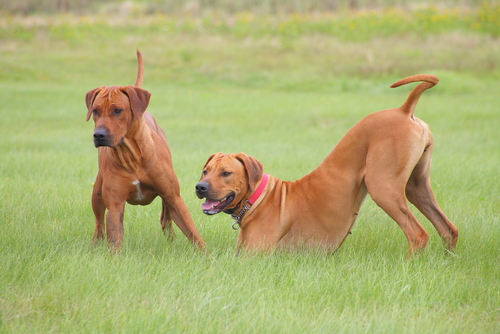Characteristics of an Alpha Dog and Other Dominant Dogs


Written and verified by the lawyer Francisco María García
Living in harmony and avoiding conflict is the way that nature normally works. And in the animal kingdom there are controls to maintain balance in groups. Alpha dominance and submission are concepts that we may hear about dogs. Do we know what an alpha dog is like? In what ways is it useful to know?
In first place, we must understand what it means for a dog to be dominant…Or better yet, understand what it doesn’t mean. A dominant dog isn’t the most violent or aggressive dog that terrorizes others in the pack.
A dominant dog is that which finds valuable resources (in nature this means food and shelter, for example, while at home this may mean a toy or a favorite spot) making use of his position, not violence.
Dominance is an element of control to keep the correct group dynamics. A dominant dog tends to be the alpha dog, or leader of the pack in which he lives. So, it’s important to know how they usually behave.

Recognizing characteristics of a dominant dog
A dominant dog might present some of these behaviors:
- Growls to assert himself in certain situations, such as when claiming food or objects.
- Tries to take food from people’s hands before they give it to him.
- Insists that his owners play with him.
- Lies down on people, jumps on people or hump’s people’s legs frequently.
- Assumes a posture of defending its owner.
- Pushes people when walking or playing.
- Holds the gaze of humans.
- Steals his owners’ bed and gets upset if they make him get off.
- Barks or howls at people, especially if he’s with his master.
- Takes over certain spots or furniture in the house.
- Insists on leaving or entering through the door before his owners or walks in front of them.
- Doesn’t like to be put on the leash for a walk.
- Is the first to arrive at the door if a stranger comes to the house.
- Doesn’t obey commands.
- Goes ahead on a walk and pulls on the leash to steer it.
Training a dominant dog
To properly train our pet we need to know its characteristics well. His or her degree of dominance is a key element in establishing the training guidelines.

Dominance and submission in dog packs are healthy, as they serve to control and balance the relationships in society. When it comes to coexistence with humans, we must teach the dog that in the family group he won’t have to defend or fight for resources.
If our dog shows signs of dominance, the focus of the training will be directed at showing him that he does not have control over the group. If we don’t confront this in a timely manner, we may have issues of aggression later on, and these could make the relationship between the pet and the family intolerable.
Behaviors to expect after educating a dominant dog
- After training, the dog must be able to obey commands.
- Our pet must learn not to growl to ask for or claim food. Once trained we should be able to touch his food, or remove it, without him becoming aggressive.
- The human must control when to play and when not to play. If the game is to find objects, the dog must bring them; when it’s a fight, we must not let him take the dominant position.
- If we decide that a dog shares our bed, he must learn that he can only do so when we let him. He must understand that the spot doesn’t belong to him.
- When entering or leaving through a door we must teach him to go behind us and not to push humans.
- We must not allow him to interrupt our meal by watching us or begging for food. His time and space for food should be defined.
- Training will show him the rules that he has to follow in order to be in step with the group that forms our family in which he lives.
Finally, now that we know what a dominant dog is like, we can teach our pet to relate in a stable way within the pack of our family.
All cited sources were thoroughly reviewed by our team to ensure their quality, reliability, currency, and validity. The bibliography of this article was considered reliable and of academic or scientific accuracy.
- Manteca, X. (2003): Etología clínica veterinaria del perro y del gato, 3ª Ed. Multimédica. Barcelona.
- Sal, E., Rosas, M., Fernández, V., Lira, B., & Santiani, A. (2010). TIPO Y FRECUENCIA DE AGRESIVIDAD CANINA A HUMANOS EN PACIENTES DE UNA CLÍNICA VETERINARIA EN LIMA. Revista de Investigaciones Veterinarias del Perú, 21(1), 35-41.
- Especialistas, A. A. D. V. E. (2019). Teoría de la dominancia en perros. Argos: Informativo Veterinario, (207), 78-78.
- García-Belenguer, S., Palacio, J., Allepuz Palau, A., & Fuentes, N. (1999). Caso clínico: Agresividad por dominancia. Clínica veterinaria de pequeños animales, 19(4), 0243-248.
This text is provided for informational purposes only and does not replace consultation with a professional. If in doubt, consult your specialist.